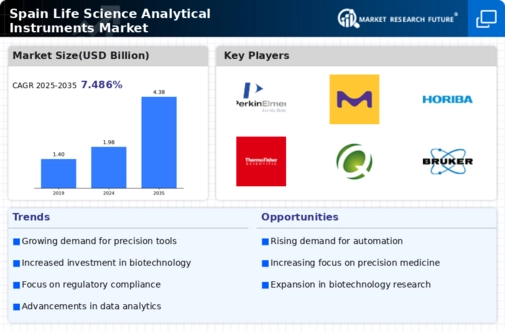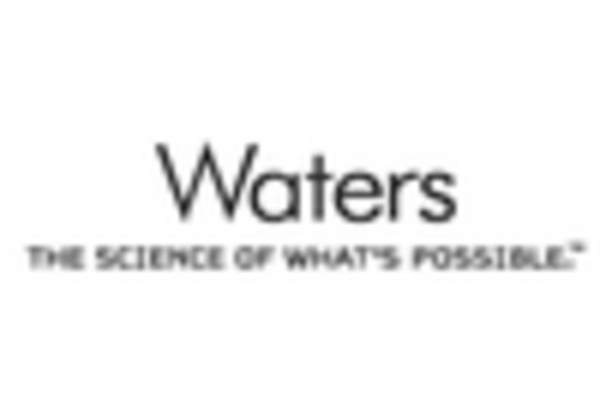Growing Biopharmaceutical Sector
The biopharmaceutical sector in Spain is expanding rapidly, which is positively impacting the life science-analytical-instruments market. With an increasing number of biopharmaceutical companies focusing on drug development and production, there is a heightened demand for analytical instruments that can ensure quality control and compliance with regulatory standards. The biopharmaceutical market in Spain is projected to grow at a CAGR of around 10% over the next few years, driven by innovations in biologics and biosimilars. This growth necessitates the use of advanced analytical techniques to characterize and quantify biopharmaceutical products, thereby creating opportunities for manufacturers of analytical instruments. The interplay between the biopharmaceutical industry and analytical technologies is likely to shape the future landscape of the market.
Investment in Research and Development
Investment in research and development (R&D) is a significant driver for the life science-analytical-instruments market in Spain. The Spanish government, along with private entities, is increasingly allocating funds to enhance R&D capabilities in the life sciences sector. This investment is crucial for fostering innovation and developing new analytical technologies that can address complex biological questions. In 2025, R&D expenditure in the life sciences is expected to reach approximately €3 billion, reflecting a commitment to advancing scientific knowledge and improving healthcare solutions. As a result, the life science-analytical-instruments market is likely to benefit from the introduction of cutting-edge technologies that enhance the accuracy and efficiency of analytical processes, thereby meeting the evolving needs of researchers and clinicians alike.
Rising Demand for Advanced Diagnostics
The life science-analytical-instruments market in Spain is experiencing a notable increase in demand for advanced diagnostic tools. This trend is driven by the growing prevalence of chronic diseases and the need for early detection and monitoring. As healthcare providers seek to enhance patient outcomes, the adoption of sophisticated analytical instruments becomes essential. The market for diagnostic instruments is projected to grow at a CAGR of approximately 8% over the next five years, reflecting the urgency for accurate and timely diagnostics. Furthermore, advancements in technology are enabling the development of more precise and efficient instruments, which are likely to further stimulate market growth. This rising demand underscores the critical role that analytical instruments play in modern healthcare, particularly in the context of personalized treatment strategies.
Emphasis on Quality Control and Compliance
Quality control and compliance are paramount in the life science-analytical-instruments market, particularly in Spain's highly regulated environment. Regulatory bodies are imposing stringent guidelines to ensure the safety and efficacy of medical products, which drives the demand for reliable analytical instruments. Companies are increasingly investing in advanced technologies to meet these regulatory requirements, thereby enhancing their operational efficiency. The market for quality control instruments is expected to grow significantly, with an estimated increase of 7% annually. This emphasis on compliance not only ensures product safety but also fosters consumer trust, which is essential for the sustainability of the life science sector. As such, the life science-analytical-instruments market is likely to see continued growth as organizations prioritize quality assurance.
Collaboration Between Academia and Industry
Collaboration between academia and industry is emerging as a vital driver for the life science-analytical-instruments market in Spain. Academic institutions are increasingly partnering with industry players to facilitate the transfer of knowledge and technology. These collaborations often lead to the development of innovative analytical methods and instruments that can address specific research needs. In 2025, it is anticipated that such partnerships will contribute to a 15% increase in the introduction of new analytical technologies in the market. This synergy not only accelerates the pace of innovation but also enhances the practical application of research findings in real-world settings. As a result, the life science-analytical-instruments market is likely to benefit from a continuous influx of novel solutions that cater to the evolving demands of the scientific community.

















Leave a Comment